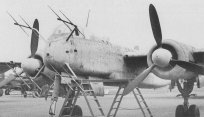
Heinkel He 219 UHU
Many features of the He 219 were at the outer edge of technology. It was the Luftwaffe's first operational aircraft with tricycle landing gear - criticised by some staff officers as 'this unneccessary American innovation.' It was also one of the first warplanes to be equipped with ejection seats, and the first to use them in combat.
Derived from Heinkel's P.1060 fighter bomber propasal, which attracted only lukewarm support in Berlin, the all metal shoulder wing He 219 seated its pilot and navigator back to back. It was a practical, sensible design and performed well but bitter opposition led by Generalfeldmarschall Erhard Milch who favoured the Junkers Ju 188, delayed production.
As a result of squabbling, the He 219 was late reaching service. But this fighter showed its cabilities on 11/12 June 1943 when a mission led by Major Werner Streib shot down five RAF Lancasters. The He 219 had some limited success in combat, but built in larger numbers it might have had a dramatic impact on the war.
It could have been the best combat aircraft of World War II, but the Heinkel He 219 Uhu suffered from misjudgements by the German high command which never used it to its best effect. Conceived as a multi-purpose warplane, it saw service only as a heavily armed night-fighter. It was one of the few Luftwaffe aircraft which stood any chance of intercepting the fast flying British Mosquito.
|

|
 |
 |
 |
| The RAF evaluated the He 219 after many were captured in 1945. The aircarft was received enthusiastically by Allied pilots, who were very impressed with its high performance and the novel ejection seat. |
The prominent aerials in the nose were part of the Lichtenstein FuG 220 radar, which was far more effective than previous sets. The secret of the FuG 220 was revealed after one was captured when a straying Ju 88 landed by accident in Britain. |
The He 219 VI prototype demonstrated excellent performance from the start. Only radar and guns were needed to turn a test aircraft into one of the finest night-fighters of the war. |
|
Heinkel He 219 UHU (Technical Specification) |
| Role |
Two-seat night fighter |
| Manufacturer |
Heinkel |
| Maximum Speed |
670 kmh (415 mph) |
| Maximum range |
2,000 km (1,240 miles) |
| Ceiling |
12,200 meters (40,000 feet) |
Weight
Empty
Maximum Takeoff |
11,200 kg (24,640 lbs)
15,300 kg (33,660 lbs) |
Dimensions
Wingspan
Length
Height
Wing Area |
18.50 meters (60 ft 8 in)
15.54 meters (51 ft)
4.10meters (13 ft 6 in)
44.50 square meters (479 sq ft) |
| Engines |
Two Daimler-Benz DB 603G piston engines which provides 1,417 kW (1,900 hp) |
| Armament |
Two upward firing 30 mm (1.18 in) MK 108
Two 30 mm (1.18 in) MK 108 in wingroots
Two 20 mm (0.79 in) MG 151/20
Two 30 mm (1.18 in) MK 103 cannon in ventral tray |
Photo Gallery
Click here to submit your photo
| Have A Passion For Aircraft? |
Subscribe to our 14 series FREE newsletter
delivered weekly on World War 2 Aircraft factfile... |
| NB:- We hate spam as much as you do, so your email address will NEVER be shared with or sold to anyone else. That's a Guarantee. |
|
|





